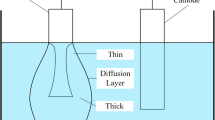Abstract
Numerical and experimental analysis of high-aspect-ratio micro-tool electrodes fabrication using a controlled electrochemical machining (ECM) technique is reported. The evolution of the tool electrode shape was first predicted using a finite element method-based numerical simulation and then validated with the detailed experiments. The effects of machining voltages and the machining durations on the change in the tool electrode profile were investigated. High-carbon steel was chosen as an electrode material due to its lower cost, good electrical conductivity, and easy availability. A 5% (i.e., 5 gm of NaCl in 100 ml of deionized water) NaCl solution was used as the electrolyte. The tool profiles predicted using the FEM-based numerical model showed an excellent matching trend with the ECM experimental results. The role of the black surface film formed on the electrode surface was found to be significant. The tool electrodes having an average diameter of 60 µm and an aspect ratio of more than 75 were fabricated at the optimized machining parameters. These single-tip micro-tool electrodes were used to create through-hole in a 400-µm-thick glass substrate by electrochemical discharge machining. The obtained ECM process parameters were used to create multiple electrodes having a tip size of 130 µm and having a smooth surface. These through-holes were filled with copper to form 3D interconnects, i.e., through-glass vias, which are required in the radio-frequency MEMS applications and 3D packaging.
Graphic abstract















Similar content being viewed by others
References
Sugioka K, Cheng Y, Midorikawa K (2005) Three-dimensional micromachining of glass using femtosecond laser for lab-on-a-chip device manufacture. Appl Phys A 81:1–10
Lee J-Y, Lee S-W, Lee S-K, Park J-H (2013) Through-glass copper via using the glass reflow and seedless electroplating processes for wafer-level RF MEMS packaging. J Micromech Microeng 23:85012
Choi JP, Jeon BH, Kim BH (2007) Chemical-assisted ultrasonic machining of glass. J Mater Process Technol 191:153–156
Jalali M, Maillard P, Wüthrich R (2009) Toward a better understanding of glass gravity-feed micro-hole drilling with electrochemical discharges. J Micromech Microeng 19:45001
Mishra DK, Arab J, Magar Y, Dixit P (2019) High aspect ratio glass micromachining by multi-pass electrochemical discharge based micromilling technique. ECS J Solid State Sci Technol 8:P322–P331
Crichton IM, McGeough JA (1985) Studies of the discharge mechanisms in electrochemical arc machining. J Appl Electrochem 15:113–119
Mishra DK, Verma AK, Arab J et al (2019) Numerical and experimental investigations into microchannel formation in glass substrate using electrochemical discharge machining. J Micromech Microeng 29:75004
Debnath S, Doloi B, Bhattacharyya B (2019) Wire electrochemical machining process: overview and recent advances. J Electrochem Soc 166:E293–E309
Sharma V, Patel DS, Jain VK et al (2018) Wire electrochemical threading: a technique for fabricating macro/micro thread profiles. J Electrochem Soc 165:E397–E405
Yu N, Fang X, Meng L et al (2018) Electrochemical micromachining of titanium microstructures in an NaCl–ethylene glycol electrolyte. J Appl Electrochem 48:263–273
Volgin VM, Kabanova TB, Davydov AD (2015) Modeling of through-mask electrochemical micromachining. J Appl Electrochem 45:679–688
Mishra K, Dey D, Sarkar BR, Bhattacharyya B (2018) Modeling on volumetric material removal for fabrication of complex shapes by EC milling of Ti6Al4V. J Electrochem Soc 165:E388–E396
Lim Y-M, Kim SH (2001) An electrochemical fabrication method for extremely thin cylindrical micropin. Int J Mach Tools Manuf 41:2287–2296
Choi SH, Ryu SH, Choi DK, Chu CN (2007) Fabrication of WC micro-shaft by using electrochemical etching. Int J Adv Manuf Technol 31:682–687
Fan Z-W, Hourng L-W (2009) The analysis and investigation on the microelectrode fabrication by electrochemical machining. Int J Mach Tools Manuf 49:659–666
Fan Z-W, Hourng L-W, Wang C-Y (2010) Fabrication of tungsten microelectrodes using pulsed electrochemical machining. Precis Eng 34:489–496
Mathew R, James S, Sundaram MM (2010) Experimental study of micro tools fabricated by electrochemical machining. In: ASME 2010 international manufacturing science and engineering conference. American Society of Mechanical Engineers, pp 73–80
Liu K, Li XP, Rahman M (2003) Characteristics of high speed micro-cutting of tungsten carbide. J Mater Process Technol 140:352–357
Dixit P, Miao J (2006) Aspect-ratio-dependent copper electrodeposition technique for very high aspect-ratio through-hole plating. J Electrochem Soc 153:G552–G559
Xu L, Dixit P, Miao J et al (2007) Through-wafer electroplated copper interconnect with ultrafine grains and high density of nanotwins. Appl Phys Lett 90:33111
Dickinson EJF, Ekström H, Fontes E (2014) COMSOL Multiphysics®: finite element software for electrochemical analysis. A mini-review. Electrochem Commun 40:71–74
Wolf AV (1966) Aqueous solutions and body fluids; their concentrative properties and conversion tables. Hoeber Medical Division, Harper & Row, New York
Haisch T, Mittemeijer E, Schultze JW (2001) Electrochemical machining of the steel 100Cr6 in aqueous NaCl and NaNO3 solutions: microstructure of surface films formed by carbides. Electrochim Acta 47:235–241
Arab J, Kannojia HK, Dixit P (2019) Effect of tool electrode roughness on the geometric characteristics of through-holes formed by ECDM. Precis Eng 60:437–447
Arab J, Mishra DK, Kannojia HK et al (2019) Fabrication of multiple through-holes in non-conductive materials by electrochemical discharge machining for RF MEMS packaging. J Mater Process Technol 271:542–553
Kannojia HK, Arab J, Pegu BJ, Dixit P (2019) Fabrication and characterization of through-glass vias by the ECDM process. J Electrochem Soc 166:D531–D538
Acknowledgements
The authors would like to acknowledge the financial support from the Ministry of Human Resources and Development (MHRD) and the Department of Scientific and Industrial Research (DSIR) through (DSIR/PACE/TDD-IMPRINT/7510). This work has been carried out as a part of the Impacting Research Innovation and Technology (Imprint) Project, initiated by MHRD, Indian Government, under the Research Grant 10007457.
Author information
Authors and Affiliations
Corresponding author
Additional information
Publisher's Note
Springer Nature remains neutral with regard to jurisdictional claims in published maps and institutional affiliations.
Rights and permissions
About this article
Cite this article
Patro, S.K., Mishra, D.K., Arab, J. et al. Numerical and experimental analysis of high-aspect-ratio micro-tool electrode fabrication using controlled electrochemical machining. J Appl Electrochem 50, 169–184 (2020). https://doi.org/10.1007/s10800-019-01380-5
Received:
Accepted:
Published:
Issue Date:
DOI: https://doi.org/10.1007/s10800-019-01380-5




